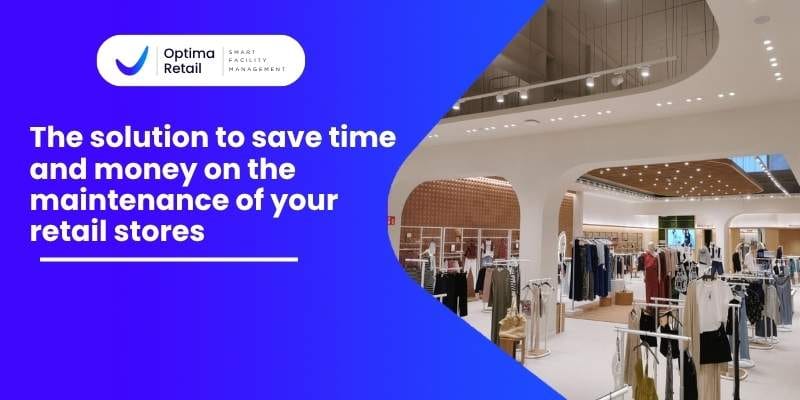
Temperature control in your store is a key factor in ensuring a pleasant shopping experience and keeping your products in optimal condition. Choosing the right air conditioning system can be the difference between a comfortable environment for customers and employees or an uncomfortable space that drives away shoppers. In this article, we will explore the different types of air conditioning for your store, analyzing their advantages, disadvantages, and the best applications for each, backed by the expertise of Optima Retail, specialists in comprehensive retail maintenance services.
At Optima Retail, we are here to help you select and install the system that best suits your needs, while also offering comprehensive maintenance services to ensure it operates optimally at all times. Trust the experts and turn your store into a comfortable, efficient, and profitable space.
The Importance of a Proper Air Conditioning System in Your Store

Before diving into the different types of air conditioning, it’s essential to understand why a good air conditioning system is vital for any business. It’s not just about providing comfort to customers; it’s also about preserving products that may be sensitive to sudden temperature changes, such as food, beverages, or electronics.
Moreover, an efficient air conditioning system contributes to:
- Reducing energy consumption, which translates to significant savings on electricity bills.
- Extending the lifespan of equipment and products within the store.
- Improving employee productivity by providing a more comfortable working environment.
- Increasing the amount of time customers spend in the store, potentially boosting sales.
“An efficient air conditioning system not only improves your store’s comfort but can also be a key factor in your business’s profitability.”
Here are the main types of air conditioning systems you can consider for your store, with a focus on how each can integrate into your commercial space.
1. Split Air Conditioning
Split air conditioning is one of the most popular options for small to medium-sized commercial establishments. This system consists of two units: an indoor unit installed within the commercial space and an outdoor unit located outside the building.
Advantages:
- Relatively easy installation without the need for major construction work.
- Low noise levels, making it ideal for stores where acoustic comfort is crucial.
- Moderate energy efficiency, ideal for spaces that do not require constant air conditioning.
Disadvantages:
- Limited capacity, making it less suitable for large spaces or areas with high ceilings.
- Regular maintenance is necessary to ensure proper functioning.
2. Central Air Conditioning
This system is ideal for large stores or those with multiple sections. Central air conditioning distributes cool air through ducts that can cover the entire store uniformly.
Advantages:
- Uniform climate control throughout the commercial space.
- Centralized control allows you to adjust the temperature in different zones according to needs.
- Clean aesthetics, as no visible units are inside the commercial space.
Disadvantages:
- High installation costs due to the need for ducts and specialized equipment.
- Complex maintenance that may require frequent professional services.
- High energy consumption, especially if the system is not optimized correctly.
3. Ducted Air Conditioning
Ducted air conditioning is similar to the central system, but its main difference lies in using air ducts to distribute cool air from a central unit to different areas of the establishment.
Advantages:
- Efficient air distribution, ideal for stores with multiple rooms or spaces.
- Zonal control allows you to adjust the temperature in different areas independently.
- Discreet aesthetics since the units are hidden in the ceiling or walls.
Disadvantages:
- Higher installation costs compared to simpler systems like Split.
- Increased energy consumption if not managed properly.
- Requires proper design of the duct system to avoid energy losses.
4. VRF (Variable Refrigerant Flow) Air Conditioning
The VRF system is an advanced and highly efficient option, ideal for stores that require precise and adaptive temperature control. This system allows a single outdoor unit to serve multiple indoor units, with the ability to adjust the refrigerant flow in each unit according to specific needs.
Advantages:
- High energy efficiency, especially in large spaces or with temperature variations in different areas.
- Individual temperature control in each indoor unit.
- Ability to integrate heating and cooling in a single system.
Disadvantages:
- High initial costs due to the system’s complexity.
- Requires specialized installation and maintenance to ensure optimal operation.
- Not the best choice for small or single-story stores due to its cost and capac
5. Precision Air Conditioning
Precision air conditioning is a specific solution for stores that require extremely precise temperature and humidity control, such as those selling electronics, pharmaceuticals, or perishable foods.
Advantages:
- Highly precise temperature and humidity control, ideal for sensitive products.
- High reliability and ability to operate continuously without interruptions.
- Energy consumption optimization in specific environments.
Disadvantages:
- High costs, both in installation and maintenance.
- Requires specific design for each type of store and product.
- Not necessary for stores where temperature control is not critical.
Factors to Consider When Choosing an Air Conditioning System for Your Store
When selecting air conditioning for your store, it is crucial to consider several factors that will ensure the efficiency and adaptability of the chosen system.
1. Space Size
The size and layout of your store are determining factors. Not all air conditioning systems are suitable for all store sizes. For example, a Split system might be perfect for a small boutique but inefficient for a department store.
2. Type of Products
If your store sells products sensitive to temperature variations, such as food or pharmaceuticals, it is essential to opt for a system that offers precise and constant temperature and humidity control, like precision air conditioning.
3. Energy Consumption
Energy consumption is a crucial factor for your business’s profitability. It is advisable to choose systems that offer high energy efficiency, especially if the store operates for long hours. The VRF system, for example, is known for its efficiency in large spaces.
4. Installation and Maintenance Costs
It is vital to consider not only the initial cost of the system but also the long-term maintenance expenses. A central or ducted air conditioning system may require more intensive and costly maintenance compared to a Split system.
5. Aesthetics and Available Space
The visual impact and available space for system installation are also factors to consider. Systems like ducted air conditioning offer a discreet aesthetic solution, ideal for stores that value a clean and minimalist design.
At Optima Retail, we are here to help you select and install the system that best suits your needs, while also offering comprehensive maintenance services to ensure it operates optimally at all times. Trust the experts and turn your store into a comfortable, efficient, and profitable space.


